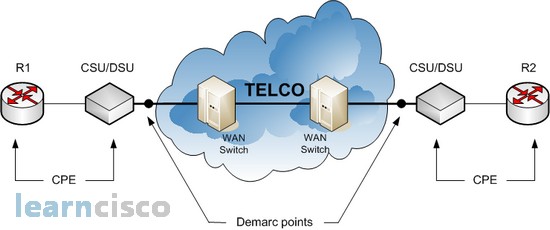The following table gives the basic definitions for the three types of WAN services:
| Term | Description |
|---|---|
| Leased Line | A dedicated, always-on circuit between two endpoints. The service provider just passes a constant rate bit stream; it does not interpret or make decisions based on the bits sent over the circuit. Generally is more expensive than packet switching today. |
| Circuit switching/dial | Provides dedicated bandwidth between two points, but only for the duration of the call. Typically used as a cheaper alternative to leased lines, particularly when connectivity is not needed all the time. Also is useful for backup when a leased line or packet-switched service fails. |
| Packet switching | Provides virtual circuits between pairs of sites, with contracted traffic rates for each VC. Each site’s physical connectivity consists of a leased line from the site to a device in the provider’s network. Generally cheaper than leased lines. |
Many options for WAN connectivity are available, including synchronous point-to-point serial links. These synchronous point-to-point links include a cable from a service provider, with the service including the capability to send and receive bits across that cable at a predetermined speed. The physical connection includes a CSU/DSU on each end of the link, as shown in the following figure.

After the CSU/DSUs are configured and the lines are installed, only a small amount of configuration is required on the routers. To get the two routers working so that they can ping each other across the link, you actually only need to configure IP addresses on each router and do a no shutdown command on each interface.
In some cases, two routers are physically close to each other, but they still need a point-topoint WAN link. You can instead do a cabling “trick,” connecting a DCE cable to a DTE cable to create a point-to-point WAN link. The schematic below shows the basic idea behind the cabling with the DCE and DTE cables, which allows the two routers to send and receive bits without a pair of CSU/ DSUs and a leased line.

Using the principal of the above picture, the configurations of both routers are as followes:
R1(config)#
R1(config)#int se 1/0
R1(config-if)#clock rate ?
With the exception of the following standard values not subject to rounding,1200 2400 4800 9600 14400 19200 28800 38400
56000 64000 128000 2015232accepted clockrates will be bestfitted (rounded) to the nearest value
supportable by the hardware.<246-8064000> DCE clock rate (bits per second)
R1(config-if)#clock rate 64000 ?
R1(config-if)#clock rate 64000
R1(config-if)#ip address 10.10.2.1 255.255.255.0
R1(config-if)#no shu
R1(config-if)#end
R1#
R2(config)#int se1/0
R2(config-if)#
R2(config-if)#clock rate 64000
R2(config-if)#ip address 10.10.2.2 255.255.255.0
R2(config-if)#no shu
R2(config-if)#end
R2#
R2#ping 10.10.2.1Type escape sequence to abort.
Sending 5, 100-byte ICMP Echos to 10.10.2.1, timeout is 2 seconds:
!!!!!
Success rate is 100 percent (5/5), round-trip min/avg/max = 16/67/120 ms
R2#
The clock rate command sets the clock rate on interfaces when a DCE cable has been used. The clock rate 64000 command sets the clock rate to 64 000 bps. If external CSU/DSUs were used, as is typical when you use an actual leased line from a provider, this command is unneeded. In fact, the router wouldn’t let you add the command to the configuration if a DTE cable was connected to the interface!
Our Recommended Premium CCNA Training Resources
These are the best CCNA training resources online:
Click Here to get the Cisco CCNA Gold Bootcamp, the most comprehensive and highest rated CCNA course online with a 4.8 star rating from over 30,000 public reviews. I recommend this as your primary study source to learn all the topics on the exam.

Want to take your practice tests to the next level? AlphaPreps purpose-built Cisco test engine has the largest question bank, adaptive questions, and advanced reporting which tells you exactly when you are ready to pass the real exam. Click here for your free trial.
